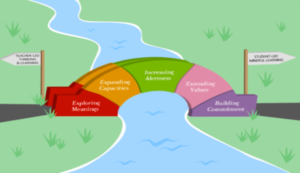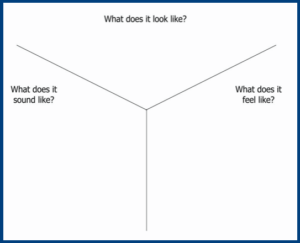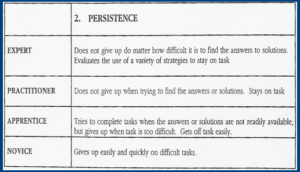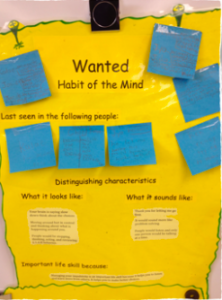Unpacking & Embedding Values and Dispositions
“We have had the posters and logos up on the wall for two years and there has been no improvement.” These were the words of a Principal in Singapore after they had identified and displayed the new school values, dispositions and skills they wanted students to learn and adopt. Passively hoping students will learn such important ideas, does not happen by osmosis. I love the words of Jenny Mosley. She says, “A teacher’s job is to get the ideas off the walls and into the students’ hearts.”
Just having posters on the wall is certainly not enough to embed values, dispositions and skills, however it is a start. In our books, Developing the Habits of Mind for Elementary School and Secondary School, co-author Graham Watts and I outline 5 ‘stages’ to implementation. As you read through these five ‘stages’ it is important to remember that this is not a linear process, nor one that has a completion, as there is always more depth, breath and personal understanding that can be gained. It is also essential to note that this is a long-term journey of embedding the values, dispositions and skills for our students. It is also not ‘yet another thing to do,’ and can be woven into your current lessons. The real power comes when every teacher, every day and every year is weaving the shared language and ideas into their curriculum.

I personally believe it is critical for teachers to have worked through these ‘stages’ and the thinking before they are introduced to the students. The ultimate goal is to assist students to move from teacher-led thinking and learning to student-led mindful learning.
Exploring Meanings
A great place to start is to explore the meanings of a value, disposition or skill. What does it mean? Create a word splash of synonyms and brainstorm phrases and quotes. The intention here is to build fluency with the terms and phrases. A word splash enhances fluency with the terms and elaborates their meaning.
I have seen a great lesson where students were given a thesaurus and asked to look up a value. The teachers then wrote the synonyms on the board, asking students to look up those words as well. When the board was covered, students, in pairs, were invited to come up with a definition of the original value. Other ideas to explore meanings, include to create an icon, posters, a four line jingle or metaphors and similes.
Expanding the Capacity
Now teachers (and students) know the meaning, it is great to be able to expand their thinking further.

Introduce a Y chart and unpack what does this disposition, value or skill look like, sound like and feel like? You may give them a task which requires the use of the disposition, to allow for deeper reflection and understanding. Watching a video of someone engaging in, or not using, the value can also assist with this unpacking.
Discuss the strategies employed to actively engage in this behaviour. For example, if you are unpacking listening, what skills do you require as a great listener? How do you know you are being a great listener? What are some of the other behaviours and values of a great listener?
From this knowledge, teachers and students can co-create simple checklists or rubrics of each value, skill or disposition.

Increasing the Alertness
At this stage the focus is on self and others. Can you recognise when you have used or employed a particular behaviour of skill? When looking at a difficult or challenging scenario, can you see which values, skills or behaviours might be useful to employ. When discussing a book or movie character, ask the question, which values, dispositions or skills do they display or maybe could have displayed? Invite teachers and students to notice and find examples of these behaviours and skills from outside the classroom. This could be bringing in news articles, videos, story books from home, examples for their community etc.
Consider if an Olympic medalist, professional musician, famous leader, a person with a disability or an animal trainer might use or demonstrate these values.
Extending the Value
Being able to recognise and explain a value, skill or disposition does not mean it is valued. Building the reasons each skill is important is an ongoing process. Hold discussions about when it might be important to engage in a certain value or behaviour and conversely when you might choose not to. As an example, consider the disposition of persistence. This is great to employ when tasks are challenging, difficult or the answer is not immediately apparent. We want students who keep going, try again and have stickability. However, there are also times to give up, leave a task and stop.
Building the Commitment
As with every skill, value and disposition, there is no tick box that you can say ‘done.’ There will always be levels, distinctions and further opportunities to develop. Goal setting is a necessary process to keeping growing. Invite teachers and older students to set goals for improvement. It’s not enough to just set the goal, they also need to identify the steps and actions required to improve. I know a teacher who set a goal to listen fully to a student’s answer, then pause and consider before giving a reply. He had previously been interrupting students before they had completed their thoughts. He reported the conversations and thinking took on a deeper quality and his Teacher-Student relationships improved.
 Another way to build the commitment and value is to reward the behaviours you wish to promote. This might be through certificates, awards and comments. At Waikiki Elementary School in Hawaii, teachers have WANTED posters in their classroom focusing on the Habit or disposition they are focusing on that month. Students are encouraged to spot the target behaviour and write a post-it note with the student’s name and what they were ‘caught’ doing.
Another way to build the commitment and value is to reward the behaviours you wish to promote. This might be through certificates, awards and comments. At Waikiki Elementary School in Hawaii, teachers have WANTED posters in their classroom focusing on the Habit or disposition they are focusing on that month. Students are encouraged to spot the target behaviour and write a post-it note with the student’s name and what they were ‘caught’ doing.
Many schools choose to have a monthly or termly focus on one or two values, dispositions or skills. This provides time to explore deeply, practice and embed. Remember this is a long game. When students are exposed to a shared language and understandings over their time at school, the uptake is higher. It’s not just about the posters on the wall!
Tags: dispositions, embedding, Habits of Mind, implementation, Karen Boyes, Karen Tui Boyes, values
Published on Wednesday, June 24th, 2020, under Curriculum design, Habits of Mind, Teacher Effectiveness
